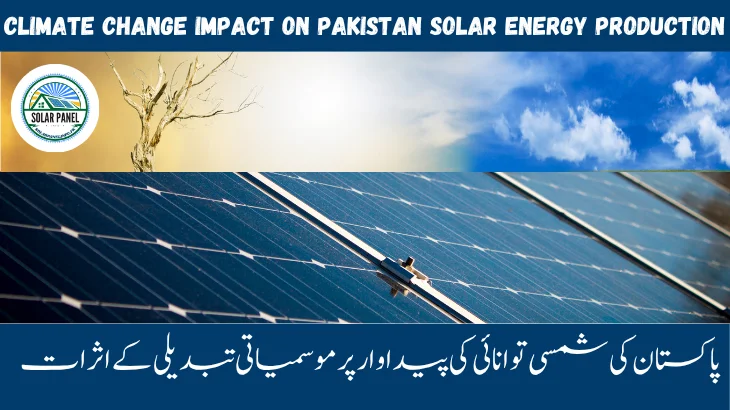Climate Change Impact on Pakistan Solar Energy Production
Pakistan is at a crucial point in its energy landscape, recognizing solar power as vital for addressing energy shortages and promoting sustainability due to its abundant sunlight. Initiatives such as the Quaid-e-Azam Solar Park and the rise of rooftop solar systems reflect this commitment. However, climate change, which solar energy seeks to combat, is threatening the efficiency and reliability of these solar initiatives, creating complex challenges for the country’s solar infrastructure.
Read Also: Solar Panel Performance vs Weather Conditions

پاکستان اپنے توانائی کے منظر نامے میں ایک اہم موڑ پر ہے، جو سورج کی کثرت کی وجہ سے توانائی کی قلت کو دور کرنے اور پائیداری کو فروغ دینے کے لیے شمسی توانائی کو اہم تسلیم کرتا ہے۔ قائداعظم سولر پارک اور روف ٹاپ سولر سسٹم کا اضافہ جیسے اقدامات اس عزم کی عکاسی کرتے ہیں۔ تاہم، موسمیاتی تبدیلی، جس کا مقابلہ کرنے کے لیے شمسی توانائی کوشش کرتی ہے، ان شمسی اقدامات کی کارکردگی اور وشوسنییتا کو خطرے میں ڈال رہی ہے، جس سے ملک کے شمسی انفراسٹرکچر کے لیے پیچیدہ چیلنجز پیدا ہو رہے ہیں۔
Impact of Cloud Cover on Solar Energy
The relationship between climate change and solar production is primarily affected by changes in solar irradiance—the amount of sunlight reaching solar panels. Key factors include:
- Increased Cloud Cover and Altered Weather Patterns: Climate change is leading to more intense monsoon seasons and unseasonal rains, resulting in increased cloud cover that can reduce solar panel energy output by 50-90% compared to clear days.
- Atmospheric Aerosols and Pollution: Rising temperatures and industrial activity are increasing dust and particulate matter in the atmosphere. Events like pre-monsoon dust storms contribute to “atmospheric dimming,” which scatters and absorbs sunlight, severely impacting solar panel performance.
Temperature and Solar Efficiency Loss
The efficiency of solar panels, or Photovoltaic (PV) cells, is significantly affected by ambient temperature, with optimal performance rated at 25°C. For every degree Celsius above this temperature, efficiency declines by 0.3% to 0.5%, known as the temperature coefficient. In Pakistan, climate change leads to more intense heatwaves, with temperatures often exceeding 40°C and reaching up to 50°C in some areas. On very hot days, solar panel surface temperatures can rise to 65-75°C, resulting in an efficiency loss of 20-25% compared to their rated capacity, particularly during peak demand hours for cooling.
Physical Damage and System Degradation
Extreme weather events linked to climate change are threatening solar installations. Key risks include:
- Hailstorms: Larger hailstones can crack or shatter solar panels, leading to costly replacements.
- Flooding: Infrastructure can be submerged, damaging panels, inverters, wiring, and mounting structures, with potential for corrosion and short circuits.
- High-Speed Winds: Strong winds can detach panels or stress the overall structure.
Dust Problems in Solar Energy
Pakistan faces challenges in solar plant operations due to its arid climate, which is worsening desertification and drought. Dust accumulation on solar panels can reduce output by 5-30%. Regular cleaning is necessary for efficiency, but it necessitates water. This resource is becoming increasingly scarce due to climate change, leading to higher operational costs and complexities for solar farms.
Implications for the National Grid and Energy Security
- The variable nature of solar generation impacts grid stability and energy planning due to climate factors.
- Unpredictable solar generation forecasts due to increased cloud variability and dust storms complicate supply-demand balancing.
- Heatwaves reduce solar efficiency while increasing electricity demand for cooling, straining the grid.
- Reduced solar output and higher maintenance costs hinder economic viability, potentially deterring future investments and slowing Pakistan’s energy transition.
Climate Factors Affecting Solar Energy
Rising Temperatures
- Positive: Increased exposure to sunlight could enhance solar radiation availability.
- Negative: High temperatures reduce solar panel efficiency by 0.3%–0.5% per °C above optimal levels; cities like Jacobabad and Multan may face reduced output during heatwaves.
Changes in Solar Irradiance
- Positive: Some regions may experience reduced winter fog and longer dry seasons, increasing solar availability.
- Negative: Increased cloud cover, monsoons, and pollution (dust and aerosols) can decrease sunlight reaching solar panels.
Extreme Weather Events
- Climate change is increasing the frequency of dust storms, heavy rainfall, hailstorms, floods, and heatwaves.
- Impacts on solar systems include reduced efficiency, increased maintenance needs, potential damage to installations, and higher risks of electrical failures.
Future Opportunities Despite Climate Challenges
- Expansion of Solar in Desert Regions: Deserts in Pakistan, such as Cholistan, Thar, and Balochistan, present opportunities for large-scale solar parks due to high solar irradiance, vast unused land, and lower cloud cover, if proper dust management is implemented.
- Advanced Solar Technologies: To combat climate change, Pakistan should adopt heat-resistant PV panels, bifacial panels, tracking systems, and dust-resistant coatings to mitigate efficiency losses from rising temperatures and dust.
Read Also: Do Solar Panel Prices Drop in Winter

- Decentralized and Off-Grid Solar Growth: Rural communities can enhance resilience to climate disasters by utilizing solar home systems, mini-grids, and solar water pumps, reducing reliance on the national grid during outages.
- Policy and Investment Opportunities: Pakistan can attract global climate financing through green energy projects, climate adaptation funds, and public-private partnerships, facilitating solar expansion amid changing climate conditions.
Recommendations for Pakistan
- Introduce climate-resilient solar designs with panels that have better heat tolerance and structures that can withstand high winds and storms.
- Promote regular cleaning infrastructure using robotic cleaning systems and water-efficient technologies.
- Strengthen early warning systems for dust storms and heatwaves, integrating climate models into energy planning.
- Invest in energy storage solutions, including batteries, pumped hydro, and hybrid systems.
- Improve air quality to enhance solar potential by reducing pollution.
Conclusion
Climate change presents both challenges and opportunities for Pakistan’s solar energy sector. While the country has abundant sunlight, factors like rising temperatures and extreme weather can reduce solar efficiency and increase maintenance costs. Adaptation measures, including climate-resilient technology and improved systems, can help mitigate these issues. By investing in advanced solar technologies and expanding solar parks, Pakistan can enhance its energy security and move toward a sustainable future despite climate challenges.
موسمیاتی تبدیلی پاکستان کے شمسی توانائی کے شعبے کے لیے چیلنجز اور مواقع دونوں پیش کرتی ہے۔ جب کہ ملک میں سورج کی روشنی بہت زیادہ ہے، بڑھتے ہوئے درجہ حرارت اور شدید موسم جیسے عوامل شمسی توانائی کی کارکردگی کو کم کر سکتے ہیں اور دیکھ بھال کے اخراجات میں اضافہ کر سکتے ہیں۔ موافقت کے اقدامات، بشمول موسمیاتی لچکدار ٹیکنالوجی اور بہتر نظام، ان مسائل کو کم کرنے میں مدد کر سکتے ہیں۔ جدید سولر ٹیکنالوجیز میں سرمایہ کاری کرکے اور سولر پارکس کو وسعت دے کر، پاکستان اپنی توانائی کی حفاظت کو بڑھا سکتا ہے اور موسمیاتی چیلنجوں کے باوجود ایک پائیدار مستقبل کی طرف بڑھ سکتا ہے۔
FAQ’s
How does climate change reduce solar energy production in Pakistan?
Climate change leads to increased cloud cover, dust, and extreme temperatures, which decrease sunlight exposure and lower the efficiency of solar panels.
Why do high temperatures affect solar panel performance?
Solar panels are most efficient at 25°C, with a 0.3–0.5% efficiency drop for each degree above, reducing output in heatwaves.
How can Pakistan improve solar energy performance under climate stress?
Pakistan can enhance solar power by using heat-resistant panels, dust-repellent technology, and water-efficient cleaning, and by investing in energy storage.


